The election of the most powerful person on the planet is only 88 days away. The two main contenders could not be more different. Of course with the campaign in full fling, albeit different from other years because of the raging pandemic, everyone wants to know: what direction is the US going to take?
Of course, there are polls, but it appears everybody is ready to read them the way they prefer. Joe Biden is leading, which pleases Democrats, but then of course the polls also had Clinton leading Trump in 2016, and look how that turned out, reply the Republicans. And then there’s the Electoral College which determines the next president, not the popular vote, which may or may not give either party an advantage. That leaves us with enough bickering for a few months.
So what we will do here, is investigate the current polling averages both nationally and per state, and correct for errors that they had historically. This will give us two key race insights:
- Joe Biden has a commanding lead
- The race is looking very stable
Joe Biden has a commanding lead
While polls show a large 8 point advantage nationally, that is not going to win him the highest office. Instead, we should look at state polling averages. But it is not clear what it tells us that Biden has a 3.5 point advantage in Arizona, with conventions, debates and months of media coverage to go. People may still change their mind and then polls have errors themselves. When looking at the race more thoroughly, we see 3 things:
- Biden has a solid lead in enough states to win him the presidency
- The national mood would have to swing by up to 6 percentage points to make the race competitive
- The Electoral College disadvantage is the Democrat’s largest projected disadvantage in almost 30 years
Biden has a solid lead in enough states to win him the presidency
To correct for the uncertainty in the race, we calculated the historical average polling error depending on how many days there are left until the election. We classified a state as Solidly D/R if the party has a chance of winning the state upwards of 90% based on the polling error, and as Leaning D/R if the party has a 2/3 chance on the state; a method we will cover in another blog.
Biden has been steadily increasing his lead so that he now solidly leads in states worth 276 votes
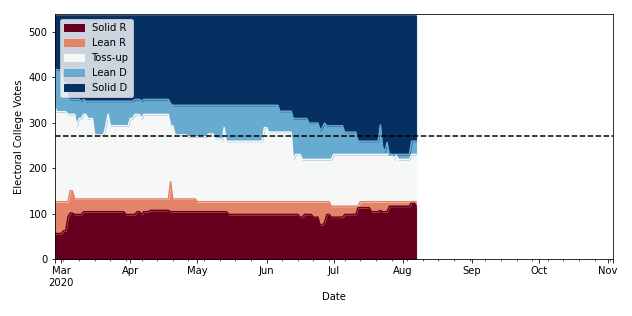
We see that Joe Biden has been steadily increasing his lead since mid-June, increasing his solid Electoral Votes, with 276 Votes in the Solid category and another
29 Leaning Biden’s way (all from Florida). This is a large advantage over Trump’s 116 Electoral College votes in states that are Solidly Republican, and 10 more in the Leaning Republican category right now. Even the names of the toss-up states (104 votes together) are enough to show that the race is Biden’s to lose: Texas, Ohio, Georgia, North Carolina and Iowa are not only tradionally red, they all went for Trump in 2016, by 3.5 to even 9.5 points.
Indeed, Clinton was only very briefly leading as Biden has been for longer now, and that was immediately after her convention which gave her a polling bounce. It’s important to note that Biden is not experiencing such an artificial polling bump right now.
Clinton’s lead was much more volatile and only as large as Biden’s just after her convention

Obviously, this does not mean Biden is a shoo-in for president. Something may still completely change the course of the race. And do not confuse the individual probability of a state to vote blue or red with the concerted efforts, since there is a lot of correlation in polling errors. But he does have a bit of slack.
The national mood would have to swing by up to 6 percentage points to make the race competitive
So how much slack does Biden have? For this, we investigate a concept called the tipping-point state. As Wikipedia notes, “the tipping-point state is the closest state that gives the winning candidate 270 or more electoral votes”. The advantage of the winning candidate in that state is the number of percentage points the entire country needs to swing to change the outcome of the election if the partisan lean of every state were to stay the same. In that sense, it’s a much more telling number than the national advantage, which is basically meaningless since there is no national vote. This year, it appears Biden can afford to lose 6 or 7 percentage points, while still winning the election.
Biden has a larger lead in the tipping-point state than Clinton had

Comparing this to Clinton in 2016, we see she shortly had this type of lead, but only immediately after her convention bounce, which (again) was not representative for her actual standing come November.
The Electoral College disadvantage is the Democrat’s largest projected disadvantage in almost 30 years
The downside for Biden is that the Electoral College, which cost Clinton her presidency, is looking even more disadvantageous for him that it was for democrats 4 years ago. The 6 percentage points he can lose in the tipping-point state is less than his polling advantage on the national level, meaning he has an Electoral College disadvantage. We can quantify this, by subtracting his national lead from his advantage in the tipping point state. If we compare this to other candidates, he is approximately at a 1.5 point disadvantage. This makes him the most disadvantaged Democrat since 1992. For now, he can bear the weight, but this may change in the future.
The Electoral College is looking historically bad for the Democrats this cycle
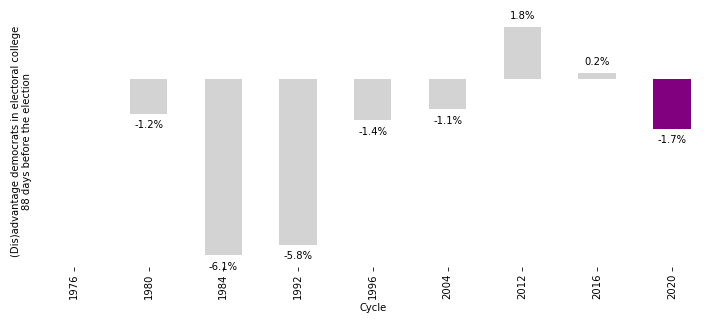
This number may of course still change during the campaign. Indeed, it did for Clinton who was looking at a small advantage at this time 4 years ago, and it cost her her presidency during the election. However, so far this cycle the Electoral College disadvantage for Democrats has been very stable:
The Democrats’ Electoral College disadvantage has been stable in 2020
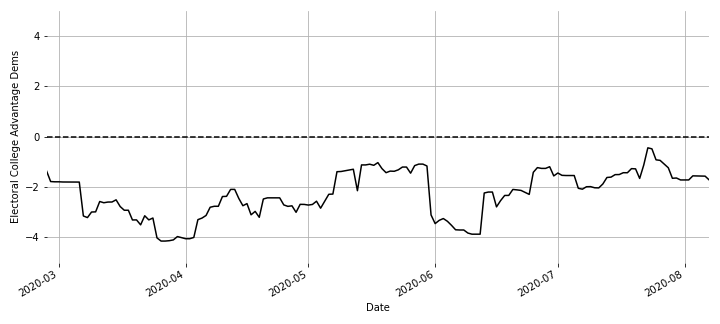
The 2020 race is historically stable
So we saw Biden’s lead is as large or larger as Clinton had on her peak, immediately following her convention. However, there’s one big difference between the 2020 and 2016 race: Biden’s lead is not only large, it’s largely stable as well.
- The 2020 cycle has been one of the most steady races in memory
- This cycle has few undecided voters compared to swingier elections
The 2020 cycle has been one of the most steady races in memory
In fact, Biden’s polling lead is one of the most robust in memory. We calculated the root-mean-square error of the polling advantage in the months April, May and June with respect to the polling advantage mean as a measure of the volatility of the race. These months don’t have the party conventions which often add a lot of volatility. The stability this race is third only to the 2004 and 2012 races, both also races with an incumbent and also comfortably won by the polling front runner. It is very different from the 2008 and 2016 races.
The 2020 volatility is close to 2004 and 2012
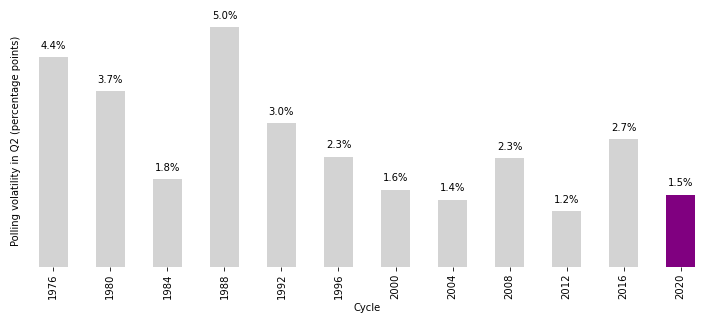
While no candidate has ever lost with an advantage in a race that has such low volatility, there is a cautionary tale:
2020 is also very close to the 2000 race
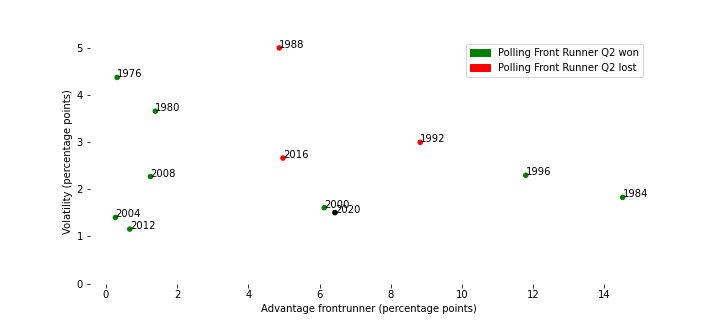
Biden’s closest match right now in terms of advantage and volatility is… George Bush when he ran in 2000. While he did manage to win, he did so very narrowly and while losing the popular vote, losing a large advantage he had.
This cycle has few undecided voters compared to swingier elections
But not only is historical volatility low, this race also features very few undecided and third party voters. This leaves much fewer voters for the Trump campaign to convince and is not boding well for future volatility, something he dearly needs.
Volatility has much fewer undecideds than the tight elections in memory
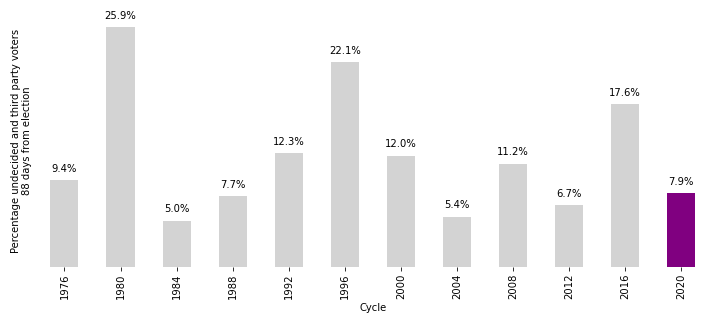
Note how this is much lower than the 2000 race we just saw, and in fact (again) much more comparable to the 2004 and 2008 races. This may be the largest difference between 2016 and 2020: many voters were on the fence at this time 4 years ago, but now, voters have their mind made up.
So Biden has a large and stable lead. Obviously, a lot can still change, especially in the special times we live in now, with a raging pandemic and the Black Lives Matter protests going on. That said, for now, the Biden’s outlook is much rosier than Trump’s .